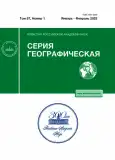Urban Agglomerations of Kazakhstan: Trends in Socioeconomic Development
- Авторлар: Makhrova A.G.1, Safronov S.G.1, Abilov A.Z.2
-
Мекемелер:
- Moscow State University, Faculty of Geography
- Satbayev University
- Шығарылым: Том 87, № 1 (2023)
- Беттер: 16-28
- Бөлім: ТЕРРИТОРИАЛЬНАЯ ОРГАНИЗАЦИЯ ОБЩЕСТВА
- URL: https://journals.rcsi.science/2587-5566/article/view/135565
- DOI: https://doi.org/10.31857/S2587556623010119
- EDN: https://elibrary.ru/LKERDP
- ID: 135565
Дәйексөз келтіру
Толық мәтін
Аннотация
The paper is focused on the recent stage in development of Kazakhstan urban agglomerations, formed as one of the priorities of state policy. Amid the absence of criteria, the boundaries of agglomerations were delimited by 1.5-hour isochrone of transport accessibility around cities with a population of over 100 000. Then, eight centers were selected using a modified coefficient of development, which took into account, in addition to urban satellites, villages with a population of over 3000. At the second stage, the degree of separation between the cores of agglomerations and zones of influence or the rest of the regions was analyzed by means of demographic and socio-economic indicators. The case of Kazakhstan has shown that the inherited structure of economy and low-comfort environment of the centers do not contribute toward the development of most agglomerations. During the post-Soviet period, their share in the population of the country increased from 43 to 52%, but the administrative approach of agglomerations “construction” works only where there are objective prerequisites and an evolutionary backlog. Of the agglomerations whose status is stated in government documents as growth points, the Almaty agglomeration is one of the most developed. The gravity zone of Shymkent includes mainly large villages, some of which have recently become towns. The capital city agglomeration in terms of development is noticeably inferior even to the neighboring Karaganda. Aktobe is able to attract residents only of the north-western regions. According to the dynamics of socio-economic development, both metropolitan agglomerations stand out, which shows the level of wages and the commissioning of housing. The three largest agglomerations are the most tertiarized, while the rest retain high employment in industry, the concentration of which in the cores does not contribute to the development of agglomerations. Except for Almaty, which is surrounded by signs of the starting suburbanization, the core cities are growing faster than their zones of influence. The suburbs lack of places for employment, a weak social infrastructure, and a lower income. This situation, which is typical of the initial stages of development, hinders the use of the classical advantages of agglomerations.
Негізгі сөздер
Авторлар туралы
A. Makhrova
Moscow State University, Faculty of Geography
Хат алмасуға жауапты Автор.
Email: almah@mail.ru
Russia, Moscow
S. Safronov
Moscow State University, Faculty of Geography
Хат алмасуға жауапты Автор.
Email: saffff@mail.ru
Russia, Moscow
A. Abilov
Satbayev University
Хат алмасуға жауапты Автор.
Email: aabilov1@mail.ru
Kazakhstan, Almaty
Әдебиет тізімі
- Абилов А.Ж., Кусаинова Г.К., Махрова А.Г. Социологические исследования при анализе формирования городских агломераций Казахстана (на примере Астаны) // Вестн. Моск. ун-та. Сер. 5. География. 2017. № 4. С. 75–83.
- Акимжанов Х.Р., Сафронов С.Г. Социально-экономическая трансформация территориальной структуры Карагандинской агломерации // Региональные исследования. 2014. № 2. С. 86–96.
- Антонов Е.В., Махрова А.Г. Крупнейшие городские агломерации и формы расселения надагломерационного уровня в России // Изв. РАН. Сер. геогр. 2019. № 4. С. 31–45.
- Афонцев С., Зубаревич Н. Пространственное развитие как механизм модернизации Республики Казахстан // Вопр. экономики. 2012. № 5. С. 53–58. https://doi.org/10.32609/0042-8736-2012-5-53-58
- Голубчиков О.Ю., Бадьина О.В. Макрорегиональные тенденции развития городов бывшего СССР // Региональные исследования. 2016. № 2. С. 31–42.
- Жумасултанов Т.Ж., Ибраев А.Т. Население Казахстана с древнейших времен до наших дней. Алматы: КИИТУ, 2000. 152 с.
- Искалиев Д.Ж. Городское расселение Казахстана: тенденции и факторы // Наука. Инновации. Технологии. 2017. № 2. С. 131–146.
- Лаппо Г.М. Развитие городских агломераций в СССР. М.: Наука, 1978. 152 с.
- Маршалл А. Принципы политической экономии. М.: Прогресс, 1983. Т. 1. 416 с.
- Кириллов П.Л., Махрова А.Г. Сценарии демографического развития агломераций Казахстана // Демографическая ситуация в Казахстане: состояние и перспективы. Вопросы истории и археологии Западного Казахстана. 2011. № 2. С. 10–22.
- Махрова А.Г., Сафронов С.Г. Тенденции развития агломераций Казахстана в XXI в. // Экологические проблемы и устойчивое развитие регионов и городов Республики Казахстан: Материалы Междунар. научн.-практ. конф., посвященной 30-летию Республики Казахстан и 20-летию Казахстанского филиала Московского университета. Нур-Султан, 2021. С. 34–44.
- Нефедова Т.Г., Слепухина И.Л., Браде И. Миграционная привлекательность городов на постсоветском пространстве на примере России, Украины и Беларуси // Изв. РАН. Сер. геогр. 2016. № 2. С. 27–38. https://doi.org/10.15356/0373-2444-2016-2-27-38
- Полян П.М. Методика выделения и анализа опорного каркаса расселения. Ч. 1. М.: АН СССР, Ин-т географии, 1988. 220 с.
- Полян П.М. Территориальные структуры – урбанизация – расселение. Теоретические подходы и методы изучения. М.: Новый Хронограф, 2014. 788 с.
- Jacobs J. The Economy of Cities. N.Y.: Random House, 1969. 268 p.
- Nyussupova G., Sarsenova I. Modern demographic processes in urban areas of the Republic of Kazakhstan // Bul. of Geography. Socio-economic Series. 2012. Vol. 18. P. 99–108.
- OECD Urban Policy Reviews: Kazakhstan. Paris: OECD Publ., 2017. 276 p.
- Zubarevich N.V. Concentration of the population and economy in the capitals of post-Soviet countries // Reg. Res. Russ. 2018. Vol. 8. № 2. P. 141–150.
Қосымша файлдар















